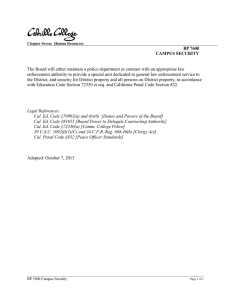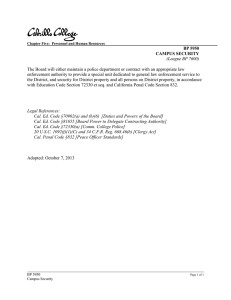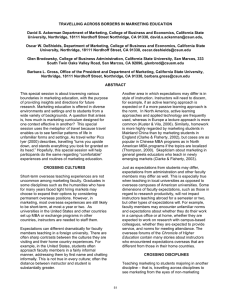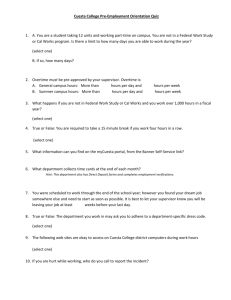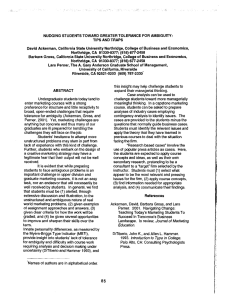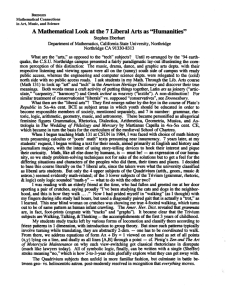California State University, Northridge: The Next Decade President’s Tenth Annual Convocation August 20, 2009
advertisement
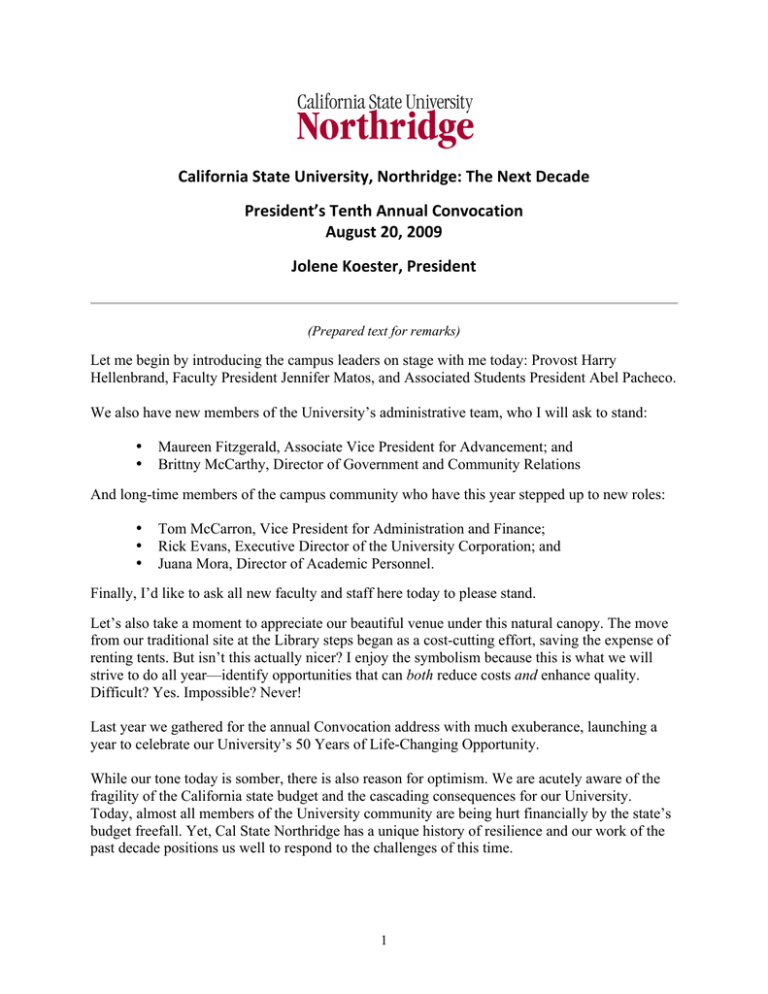
California State University, Northridge: The Next Decade President’s Tenth Annual Convocation August 20, 2009 Jolene Koester, President (Prepared text for remarks) Let me begin by introducing the campus leaders on stage with me today: Provost Harry Hellenbrand, Faculty President Jennifer Matos, and Associated Students President Abel Pacheco. We also have new members of the University’s administrative team, who I will ask to stand: • • Maureen Fitzgerald, Associate Vice President for Advancement; and Brittny McCarthy, Director of Government and Community Relations And long-time members of the campus community who have this year stepped up to new roles: • • • Tom McCarron, Vice President for Administration and Finance; Rick Evans, Executive Director of the University Corporation; and Juana Mora, Director of Academic Personnel. Finally, I’d like to ask all new faculty and staff here today to please stand. Let’s also take a moment to appreciate our beautiful venue under this natural canopy. The move from our traditional site at the Library steps began as a cost-cutting effort, saving the expense of renting tents. But isn’t this actually nicer? I enjoy the symbolism because this is what we will strive to do all year—identify opportunities that can both reduce costs and enhance quality. Difficult? Yes. Impossible? Never! Last year we gathered for the annual Convocation address with much exuberance, launching a year to celebrate our University’s 50 Years of Life-Changing Opportunity. While our tone today is somber, there is also reason for optimism. We are acutely aware of the fragility of the California state budget and the cascading consequences for our University. Today, almost all members of the University community are being hurt financially by the state’s budget freefall. Yet, Cal State Northridge has a unique history of resilience and our work of the past decade positions us well to respond to the challenges of this time. 1 As the last academic year ended, I had a plan and a theme for this Convocation address—to focus on this University’s next decade. While today’s speech has the same title, by necessity it is substantially different. I don’t typically use the Convocation to focus on budget! But our budget circumstances are akin to the elephant in the room (or the quad!) so I am going to begin with that subject. Then I will place Cal State Northridge in the context of key issues affecting all of public higher education as a way of describing how we will respond to these fiscal and other crises for the longer term—and here is the source of the optimism that I hope to share with you. Third, I will summarize our priorities for this academic year. Finally, I will close with a reminder of what we are about—our mission—by describing some accomplishments of the previous year. Let‘s start with our major preoccupation—the budget and furloughs. We simply cannot deny the very real difficulties facing members of our campus community and the students we serve. The consequences of the current budget reductions are both painful and personal for all. Furloughs mean reduced income for employees. They also have caused confusion and anxiety and less time in which to accomplish our goals. The toll on the University is enormous. As I said in the budget forums in mid-July, we have no file that gives us history or best practice on how to “do” furloughs. But let’s also recognize that furloughs do protect jobs and health care benefits, and are more humane than the alternative of layoffs. The budget situation we face was caused by a deep economic recession, structural problems within the state, and a long history of saying “yes” to ballot initiatives that both reduced state revenue and increased state spending. It is important as we go forward to resist the urge to demonize elected officials, the chancellor, the campus administration, other faculty or other staff. Blame is easy, but ultimately empty. To ensure our strength as a University, and our personal and professional well-being, we must not be a “house divided.” We must resist recrimination and blame. Damage is also being done to our ability to fulfill our mission to serve the needs of the people of this region. Current students will experience the impact of furloughs through longer wait times and reduced services. Prospective students were turned away this year and more will be turned away next year. Our required enrollment reductions will bring us back to the enrollment level of 2001-02! I will not recite all the budget numbers other than to say that our reduction is large—a 24 percent reduction from our 2007-08 state appropriation base. You can read the details on the University’s budget webpage. We are addressing this budget cut through a combination of one-time savings from furloughs, use of campus reserves, some minor cuts to divisions, and additional revenue as our students pay higher fees—undergraduates, for example, will pay $978 more for the 2009-10 academic year than they did in 2008-09. There are two further obvious and almost immediate challenges to our fiscal stability. First, California’s economic fortunes appear to be in a continuing downturn. The state budget we are now implementing will become defunct if state revenues continue to fall, and so we may see additional budget cuts. That, coupled with no federal stimulus money next year to backfill state reductions, makes predicting 2010-11 highly capricious. 2 Now, many of you are asking, where is the optimism I referred to earlier? My optimism stems from understanding—knowing—that Cal State Northridge has already made critical changes that allow us to respond effectively to the current fiscal situation and other major issues affecting all U.S. public higher education. While it is difficult—very difficult—at times like these to focus on other than the “here and now,” it is to the future that we must attend. Much of what the future demands of us is signaled by major issues facing U.S. public higher education, which together herald a pathway to our better future. If you are a pessimist, you view these as obstacles; if you are an optimist, you see them as opportunities; and, if you are a realist, you see a map of the terrain that lies ahead. Clearly, I approach these national issues as signals for Cal State Northridge’s optimism and realism for our planning. Bear with me now—I promise not to get too abstract and distant from the issues we face today. Let me start with an issue we began grappling with earlier this decade—and which we feel acutely at this moment—the erosion of state support for public higher education. This is a national, not just California, force. In 2003 I offered the image of Cal State Northridge being asked to fulfill our mission, first in a vehicle the size of a luxury SUV, then in smaller, more utilitarian vehicles, to the point that I suggested we were being asked to pack all our programs, faculty, staff, and students into a Volkswagen. Today we have something the size of a “Smart Car,” and we are asking you to ride in the car some days and park the car on others. In California our ability to fulfill the vision of the Master Plan has been severely compromised. The Master Plan envisioned low fees and high state financial support for public higher education. That proportional relationship has been set askew. Low fees depend on healthy tax returns and a public commitment to fund higher education proportionally. Neither factor is a political driver today. A piece of evidence that supports this point—the California prison system is funded at about the same level as all of public higher education, that is, all 10 UC campuses, 23 CSU campuses, and 107 community colleges. The relationship between state revenues, student fees or tuition, access, and affordability must be rethought. Despite increases in student fees, our base budget has been severely reduced, and we have had to reduce enrollment, sacrificing our commitment to access for all who are eligible. I do believe that the CSU and, in particular, Cal State Northridge have critical roles to play in offering the route to higher education for those previously underrepresented. We must ensure that lower income individuals are not disenfranchised from higher education because of prohibitive fees. But we must also ensure that the fee structure provides for quality and access. While this is not an issue we alone have the power to resolve, we do have the advantage of having earlier built additional campus-based revenue streams from self-support academic programs, nonresident students, and the Campus Quality Fee. At the state and system levels, our role is to participate in the dialogue, raise questions, do the analysis, and understand the consequences of choices facing the people of California. These choices have enormous consequences for public higher education and the future of the state. 3 The second national issue is one we at Northridge have grappled with for some time—improving how the University supports the student learning process. We have focused formally on this almost since the beginning of the decade with our efforts as a learning-centered university. I spent part of my summer—when I wasn’t dealing with budget and furloughs—reading the work of Carl Wieman, a Nobel Prize winning physicist, who has devoted considerable research energy to questions of if and how students in his introductory physics classes learn. He makes a compelling argument, using direct evidence, that traditional pedagogy—lecture and lecture/discussion—does not match what cognitive psychologists have learned through research about how students learn.i In short, because we are already committed to being a learning-centered university, we have the capability to continue to develop curriculum and pedagogy to reflect the way scientists have determined people best learn, and to continue to generate and use research evidence to improve learning. Similarly, Cal State Northridge is a national leader in integrating out-of-class learning outcomes with curricular learning outcomes, and we must build on this foundation. A third critical national issue is the so-called “achievement gap”—an issue related to concerns about student preparedness for college-level work—which sees individuals from previously underrepresented groups admitted to colleges at lower rates, and continuing and graduating at lower rates. Allowing this achievement gap to exist undermines the very basis of democracy and the “American dream.” Closing this gap must become our issue and our responsibility. So far, we have not taken adequate responsibility for the reality that we prepare large numbers of K-12 teachers and decision-makers, and the standards we expect for freshmen students are not clear to our colleagues in K-12. Solutions must begin at the local level by filling the current chasm between K-12 and the University. Again, Provost Hellenbrand, with our deans and faculty leadership, have already committed to this effort. The fourth major national issue is best captured by asserting again the importance of building and maintaining our positive reputation. Demands for accountability on the part of U.S. higher education have not been quieted. We remain far too mysterious to the public. At best, they see elusive evidence and documentation that we are worthy of the funding we receive. The public— prospective students, parents, employers, taxpayers, alumni, and donors—must be able to understand how our mission differs from other types of higher education institutions and how we accomplish it. While Cal State Northridge is a visible participant in the nationwide Voluntary System of Accountability, we must continue our work toward documenting the worth of the education we offer students and use outcome assessments to demonstrate what our students achieve. Our publics must see Cal State Northridge as a societal or “public benefit,” not just an individual one. The final national issue is often framed around competition and the threat from proprietary or for-profit institutions. I frame this issue differently because I see it as the need for our University to become more convenient and transparent in how we deliver academic programs and support services. Technology is a key tool here, but unless we are willing to make fundamental changes in how we do our work, technology will simply be an expensive add-on to an otherwise unchanged process. We have focused on remaking our business processes, but there are still major challenges—and opportunities—ahead. 4 In the coming year we need to continue our work and accelerate our pace in responding to the dilemmas created by these national forces. This University’s future is linked to how these are shaped and resolved. I see tremendous opportunity on the horizon for Cal State Northridge because we have correctly anticipated these trends and already begun to respond. We have the capacity as a University to tame these forces such that we will be even better in the future. The national forces just discussed then shape our campus agenda for the coming academic year. While our priorities and planned initiatives have shifted, our energies must be devoted to maintaining the core functions of the University—to supporting student learning and maintaining the quality of our academic programs. Furloughs reduce the time available to do our work, but the work must focus on our mission and on our students. While the University plan will continue to guide us, our progress will be slower. We must manage our human and fiscal resources differently in order to shape a future University that functions effectively with fewer state dollars. The vice presidents, with help from you, will begin shortly to develop a three-year budget plan that recognizes the need for fundamental changes. It is important to understand that, even when the state’s economic recession is over, we cannot expect state dollars to flow again in equal measure. Second, as a distinct but linked effort to the budget plan, I have asked the vice presidents to lead the campus community in developing an approach to evaluate, reprioritize, change, and/or eliminate aspects of administrative functioning to create baseline or structural savings. A symbol of what we must do more broadly is the relocation of this Convocation address to a different site—saving money while maintaining or even enhancing quality. A third requested plan addresses the enrollment reductions we have been directed to make for next year, while simultaneously protecting the longer-term desirability of Cal State Northridge as a university of choice and as a university that places the highest value on access for eligible students. Let me as well acknowledge that, initially, we are spending a great deal of time making the furloughs “work”—at least as well as we can. Over the year, this should get easier. Also on the agenda for this academic year are: • • • Preparations to open the Valley Performing Arts Center in 2010-11. Continuing efforts to highlight and strengthen the positive reputation of the University by bringing our web presence and services into the Web 2.0 world. This includes launching phase one of the new student portal, a collaboration by Information Technology, Student Affairs, University Advancement, and Academic Affairs. In the spring, two visits from WASC as part of our reaccreditation reviews. All of these 2009-10 efforts are directed toward preserving our future excellence. 5 Finally, let me remind you of that excellence by reviewing some of the many achievements of the past year. As I recap our strengths and distinctions, I hope that you will agree with me that Northridge is a regionally focused but nationally recognized university. • • • • • • • • Over 10,000 bachelor’s and master’s students in 64 fields were eligible for our 2009 commencements. We are ranked fifth in the nation, and first among California institutions, for awarding bachelor’s degrees to Hispanic students, and tenth for awarding masters degrees. We rank tenth in baccalaureate degrees conferred to all minorities. On April 25, nearly 3,500 alumni, current and former faculty and staff, neighbors, and family members came together on this campus to celebrate the University’s first all-class Grand Reunion in celebration of our 50th anniversary. Several construction projects were just completed—a new science building, Chaparral Hall; the G3 parking structure; a new residence hall designed to meet the needs of firstyear students; and the remodel of Geronimo’s dining hall in the Satellite Student Union. During the spring semester, through broad participation of staff and faculty from the entire campus, Cal State Northridge successfully completed its 10-year NCAA recertification. We have examples of how Cal State Northridge is carrying on the critical work of engaging with K-12 education to help close the “achievement gap” I spoke of earlier. For example, the Eisner College of Education received a grant from the Orfalea Foundation to train new teachers on the neurodevelopmental characteristics of all learners in their classrooms. And, State Farm awarded a $200,000 grant to develop an arts program to provide hundreds of K-12 teachers with training in arts education. Our students continue to benefit from excellent and distinguished academic programs. Among the many notable achievements of the past year: o The Keck Foundation awarded $500,000 for a 2-year project for undergraduate engineering and science students to study and develop nanotechnology. o Working together, Physical Plant Management personnel and faculty and students in the Colleges of Engineering and Computer Science and Science and Mathematics created a simulated tropical rainforest environment adjacent to the fuel cell satellite plant. o The Princeton Review profiled our College of Business and Economics in its Best 296 Business Schools, describing it as providing “solid preparation in marketing, general management, teamwork, communication/interpersonal skills, presentation skills and quantitative skills.” o The Eisner College enrolled its first cohort in the new Doctoral Program in Educational Leadership for K-12 administrators. A similar program for community college administrators begins this fall. o Students in the Center for Visual Communications produced “The Green Revolution,” a commercial for Ford, one of only four student-created ads selected from among 23 entries to air on Southern California television last September. Our faculty members continue to be recognized for their outstanding scholarly and creative contributions. The number of notable research projects and awards are far too numerous to cite, but here are just a few examples: 6 o Biology professor Steven Oppenheimer was recognized by President Obama as one of 22 professors nationwide to receive the Presidential Award for Excellence in Science, Mathematics, and Engineering mentoring. o Biology professor Peter Edmunds received more than $1 million in grants from the National Science Foundation to support his research on the world’s coral reef population. o Cinema and Television Arts Professor Thelma Vickroy’s examination of the life of comedian Ahmed Ahmed took top honors at the 2008 Action on Film International Film Festival. Her documentary was named both “Best Comedy Feature” and “Best Documentary Feature.” o Professor Emeritus Jane Prather received the Pacific Sociological Association’s 2009 Distinguished Contributions to Teaching Awards; and Professor Mary Curren received the Marketing Educators’ Association’s 2009 Marketing Educator of the Year award. • And let’s not forget, Cal State Northridge athletics had an extraordinary year: o Both the men’s and the women’s Track & Field teams won their 2009 Big West Conference Championships—the fourth consecutive championship for the women’s team and the fourth in the past six seasons for the men. Coach Don Strametz was named Coach of the Year for both teams, his tenth such title. o The women’s Water Polo team won their Big West Conference Championship. o The men’s Volleyball team won a school-record of 24 matches, and was ranked first in the nation for two consecutive weeks. o Men’s Basketball won the Big West Tournament, and advanced to the NCAA Tournament for the second time in our history. For a second straight year, Coach Bobby Braswell was named Big West Conference Coach of the Year. As always, I have had to be selective in celebrating the accomplishments of the previous year. What is different this year is the recognition that this quality, this excellence, this distinction, this laudatory fulfillment of our mission is worthy of our efforts to fight to preserve such quality for our future. That is what this year and this decade must be about! The contributions of Cal State Northridge to this region are worth our work in addressing straight on the national issues I described in order to be good stewards of the University’s future. And, this brings me to a reminder of one additional advantage we have-– we are a University community committed to student success and academic quality. These are difficult times—institutionally and personally for members of our campus community—but this University is familiar with, and has overcome, difficulty. And, we can, will, and must stand together to protect the future. We can and will navigate this economic downturn and make choices to protect the University’s ability to serve the needs of the people of this region. With respect, admiration, and appreciation I ask you to join with me in protecting the future of this great University. Let us work together, serve together, and yes, sometimes even sacrifice 7 together, for the future of this University and public higher education. Then, regardless, we win, together. i See, for example, Wieman, Carl (2007), “Why Not Try a Scientific Approach to Science Education?” Change: The Magazine of Higher Learning, September‐October. 8
